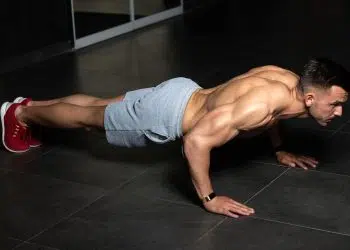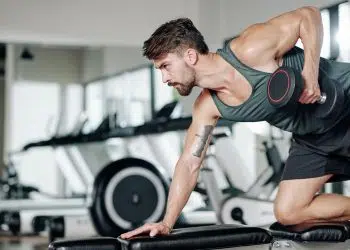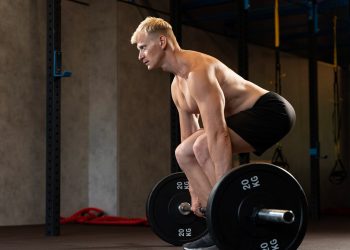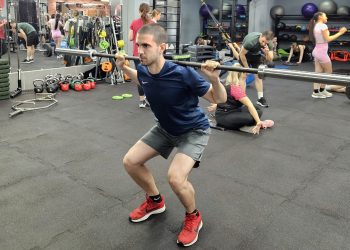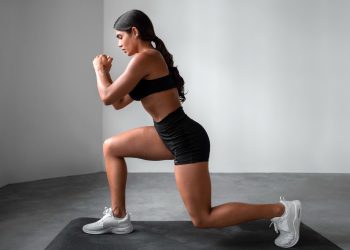The hyperextension, also known as the back extension, is an exercise that doesn’t get as much attention compared to other movements that work the same muscles. However, it’s a mistake to overlook such a beneficial and versatile exercise. It’s one of the best ways to build and strengthen your posterior chain (backside of the body) muscles that include erector spinae and hamstrings.
These muscles are often neglected and not as fun to train for many, however, you should be training them for balance and functionality.
You can use just your bodyweight or add more resistance so that you can continue to make progress. We like this exercise for its simplicity and effectiveness.
In This Exercise:
- Target Muscle Groups: Erector Spinae, Hamstrings
- Type: Strength
- Mechanics: Compound
- Equipment: Hyperextension machine
- Difficulty: Beginner
Muscles Worked
Below we’ve included brief descriptions of the muscles involved. This will help you to plan your workouts accordingly.
Erector spinae
The erector spinae is a core muscle group that spans the length of your back along your spine on either side. It’s a back extensor that allows you to stand straight and bend backwards.
It’s a very important assister in many total body movements like deadlifts, good morning, squats, etc.
Level Up Your Fitness: Join our 💪 strong community in Fitness Volt Newsletter. Get daily inspiration, expert-backed workouts, nutrition tips, the latest in strength sports, and the support you need to reach your goals. Subscribe for free!
Hamstrings
The hamstrings is a three-headed muscle group consisting of semitendinosus, semimembranosus, and biceps femoris.
This muscle group is located on the back of the upper leg opposite the quads and functions to extend the hips and flex the knees. It’s important to note that the short head of the biceps femoris only crosses the knee joint and not the hip like the other two muscles.
The hamstrings play an important role in standing but also explosive activities such as sprinting and jumping.
Additionally, this three-headed muscle is active during the gait cycle to resist knee extension, plus it stabilizes the knee joints and has other functions too.
Glutes
Everyone likes a nice booty and well, this exercise is just one of many that can help you get it.
The butt is composed of a few different muscles such as the gluteus maximus, gluteus medius, and gluteus minimus.
The gluteus maximus forms most of the superficial appearance of the butt and hips and is a very important muscle for function and aesthetics.
But the glute medius is a commonly affected muscle as many of us sit all day. It gets weak and this can cause lower back issues and knee pain. So it’s important to isolate the glutes to prevent these potential problems.
The butt primarily extends and externally rotates the thighs and it plays an important role in helping us to maintain an upright posture.
Hips
The hips are a very important muscle group to keep mobile and flexible. As we get older, hips are a common problem area because of many reasons including bone degeneration and lack of mobility.
Related: 13 Ways to Avoid Hip Pain in The Gym
How To Do The Hyperextension
For some variety we’ve included two ways to do this exercise. One is the more conventional and common method while the other is worth trying to see which one suits you best.
Basic hyperextension
- Position yourself on the hyperextension machine so your legs are secured and your hips (not stomach) are in contact with the padding.
- Keep your knees slightly bent and make sure you have room to bend your torso down and forward.
- Cross your arms on your chest and lean forward as far down as possible.
- Lift your torso up until in line with the rest of your body or slightly hyperextend at the top.
- Repeat for the desired number of reps.
Cat stretch version
- Position yourself on the hyperextension machine so your legs are secured and your hips (not stomach) are in contact with the padding.
- Keep your knees slightly bent and make sure you have room to bend your torso down and forward.
- Cross your arms on your chest and lean forward while replicating a cat stretch and keeping your upper body parallel to the floor. Flex your abs like a crunch during this portion of the movement.
- Reverse this motion while remaining in place as shown in the video tutorial below. You pretty much want to just straighten your back and pull your shoulders back.
- Repeat for the desired number of reps.
Tip: Also try the standing version shown in the video below as it offers many benefits and does not require any equipment. This will also help with the machine version.
We’ve included a video below of how to do this variation.
Hyperextension Tips
- While you may slightly hyperextend at the top and it won’t hurt anything, it’s recommended to only come up far enough until your torso is in line with your body. It’s good to use a mirror to check your form. If you feel any pain or pinching do not continue.
- Use your body weight first if just starting out. After you learn the movement and can do it with ease then add more weight. A good way to do this is to hold dumbbells, a weight plate, or attach bands to the hyperextension.
- Make sure to do the movement slow and controlled.
Benefits
There are a few benefits to doing the hyperextension.
Better looking backside
Similar movements are a must in our opinion because they allow us to maximally develop the butt, hamstrings, calves, and back muscles. When done with intensity, you’ll build muscle and in combination with a proper training program, a more complete physique.
Increase rear strength
Deadlifts, squats, pull-ups, presses… a strong posterior will make all of your lifts better and you’ll also progress faster.
Many avoid training their rear muscles or they forget to pay enough attention to the muscles that they cannot see as easily as the chest, quads, abs, etc.
The problem with this is that the body needs balance to perform at its best. Whether you play sports, are generally active, or even want to maximize your aesthetics you should give equal attention to every muscle group.
The hyperextension is also a good choice for people to enhance their mobility and flexibility.
Teaches good posture
To make this movement work you have to maintain proper posture. No slouching or rounding your back. Honestly, you can never do enough to ensure you’re strengthening your posture.
Easy to setup and perform
There’s not much setup time or thinking required to do this exercise. Simply set the machine to the desired height and you can use your own bodyweight to get a great workout. Then if you want to add more resistance just grab a few dumbbells or a weight plate and you’re good to go.
Level Up Your Fitness: Join our 💪 strong community in Fitness Volt Newsletter. Get daily inspiration, expert-backed workouts, nutrition tips, the latest in strength sports, and the support you need to reach your goals. Subscribe for free!
Drawbacks
There honestly aren’t many drawbacks to this exercise.
Can cause injury if done incorrectly
Hyperextending too much can cause pain and eventually injuries. The goal is not coming us as high as you possibly can but rather until your torso is in line or just slightly hyperextended only to where it feels natural.
May not be as comfortable compared to other exercises
The hyperextension requires leaning your hips into the machine and for some this can be a little uncomfortable. However, this shouldn’t be the case when using a sufficiently padded hyperextension contraption. You can usually always adjust the machine too to ensure everything feels good.
Hyperextension Alternatives and Variations
While the basic hyperextension gets our approval, you might also want to check out these variations and alternatives.
1. Stability ball hyperextension
You could use a stability or exercise ball to do this exercise. It may be more difficult as the ball moves but hey it’s good for training your core stability and total body balance.
2. Twisting hyperextension
By rotating during the movement you can engage your oblique muscles. The twisting hyperextension is another good variation that allows you to train an additional muscles with a simple modification.
3. Reverse hyperextension
The reverse hyperextension is similar however opposite the movement of the basic hyperextension. Using a machine or weight between your feet, the movement involves lifting your legs up and down rather than your torso. Check it out here.
4. One leg hyperextension
Aside from adding external resistance, using one leg will place more of the load on that one side. This makes it more challenging but a good option when you get more advanced.
5. Glute focused
Want to make your butt the focus? Here’s a video example that shows how to do this.
6. Cable pull through
The cable pull-through involves a hip hinge movement which is an essential part of being well-rounded and functional. It’ll also still work the same muscles as the hyperextension.
Here are some cable-pull through alternatives if you like this exercise.
7. Kettlebell swing
Perhaps one of the most functional exercises that you can add to your workout routine. The kettlebell swing involves triple extension of the joints (ankles, knees and hips) which mimics athletic activities and therefore has several benefits. Explosiveness, power and athleticism are all improved with swings.
Don’t have a kettlebell? No worries, use dumbbells or anything similar.
9. Romanian deadlift
8. This deadlift variation is more popular than ever with many replacing the conventional version for this one. You don’t touch the weight to the floor like with the regular deadlift but this has advantages.
For one, it prevents you from using too much weight and you’re forced to maintain good posture and control the weight. It’s also good for stretching out the hamstrings and offers strength benefits.
It’s just an overall amazing posterior chain developer.
Romanian Deadlift Vs. Conventional Deadlift: Which One Should You Do?
10. Hip thrust
The hip thrust is a beast of an exercise that you can really load up the weight on and build lots of mass and strength. It’s also a really good option for athletic training. It’s a little more involved regarding the setup but more than worth it for the results it produces when done right.
Here’s a list of hyperextension alternative exercises that we highly recommend you check out.
How To Incorporate The Hyperextension Into Your Training Regime
There’s no perfect answer to this. It really depends on your goals and how you structure your workouts.
With that being said, the hyperextension should not be the only exercise that you do for your posterior chain but rather in addition to the main multi-joint movements. For example, deadlifts and hip thrusts work the same muscles however they allow you to use more of your body and therefore can develop more overall mass and strength when done right. They’re also arguably more functional.
The hyperextension is still an awesome option though to add in as a warmup and/or finisher exercise.
You can find an example workout routine using a variation of the hyperextension exercise in this guide.
Try the Hyperextension for a Better Backside
The hyperextension also known as the back extension is one of the best exercises that you can do period. It’s easy to learn and you only need your body weight to reap the benefits. It’s a great glute, hamstring and back builder and we hope you’ll use the tips and information in this guide to include it in your workout routine.
Check out our top hyperextension machine picks for 2022
Interested in measuring your progress? Check out our strength standards for Good Morning, Pull Ups, Deadlift, and more.



